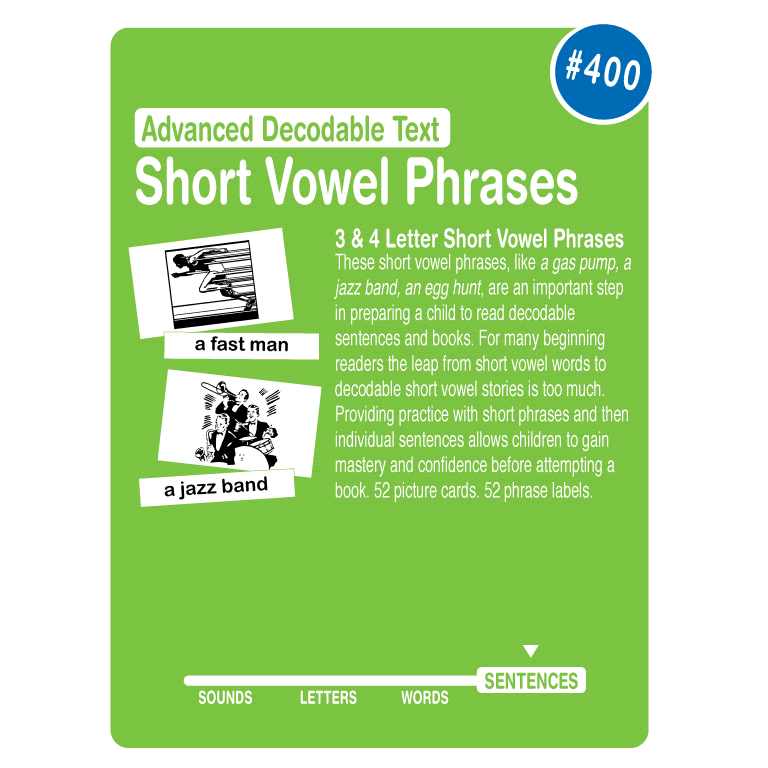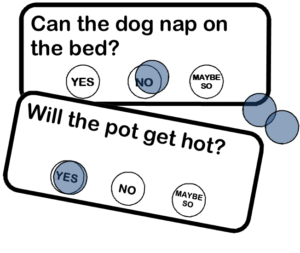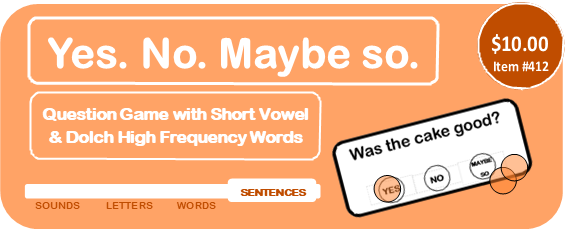Preparing the Child for Books
Before directing a child to a book—even a hightly decodable one—the child needs to successfully tackle the decoding of simple phrases and short sentences. This is a step that is almost never provided beginning readers but is crucial to their sense of mastery and self-confidence. Perception is everything; and a young child who thinks she is being given too much, too fast, may give up or withdraw. But she can almost always handle slight increases in challenge.
Provide practice with short vowel phrases and sentences.
Give the child opportunity to gain mastery and confidence with material that is only slightly more difficult than the 4- & 5-letter words he’s been decoding to this point—before introducing decodable readers that have many words in each sentence and several sentences on each page.
Short Vowel Phrases
3 & 4-Letter Short Vowel Phrases
Price: $10.00
Item #400
These short vowel phrases, like a gas pump, a jazz band, an egg hunt, are an important step in preparing a child to read decodable sentences and books. For many beginning readers the leap from short vowel words to decodable short vowel stories is too much. Providing practice with short phrases and then individual sentences allows children to gain mastery and confidence before attempting a book. 52 picture cards. 52 phrase labels.
Continue reading →These short vowel phrases, like a gas pump, a jazz band, an egg hunt, are an important step in preparing a child to read decodable sentences and books. For many beginning readers the leap from short vowel words to decodable short vowel stories is too much. Providing practice with short phrases and then individual sentences allows children to gain mastery and confidence before attempting a book. 52 picture cards. 52 phrase labels.
Continue reading →Short Vowel Sentences
3 & 4-Letter Short Vowel Sentences
Price: $10.00
Item #410
From short words to longer words to phrases and now sentences. The child has progressed at his own pace through an increasingly more challenging sequence of beginning decoding material. These short vowel sentences (The twins get wet. The man pumps gas.) allow the child to have crucial practice decoding, blending and comprehending complete sentences. Many young readers need this work in order to be successful when they attempt to read a decodable book that has many words in each sentence and several sentences on each page. 48 picture cards. 48 sentence labels.
Continue reading →From short words to longer words to phrases and now sentences. The child has progressed at his own pace through an increasingly more challenging sequence of beginning decoding material. These short vowel sentences (The twins get wet. The man pumps gas.) allow the child to have crucial practice decoding, blending and comprehending complete sentences. Many young readers need this work in order to be successful when they attempt to read a decodable book that has many words in each sentence and several sentences on each page. 48 picture cards. 48 sentence labels.
Continue reading →Yes. No. Maybe so. Question Game with Short Vowel Sentence Reading
Short Vowel Sentence Reading Game
Price: $10.00
Item #411
Yes. No. Maybe so. Question Game with Short Vowel & Dolch High Frequency Words
Question Game with Short Vowel & Dolch High Frequency Words
Price: $10.00
Item #412
Provide workbooks that reinforce what the child has already learned.
Workbooks can give beginning readers a lot of great sentence reading practice but are best used when they reinforce what a child already knows or can do, not as a means of teaching new concepts or introducing new levels of difficulty. A workbook doesn’t need to be a consumable. Individual pages can be cut out and slipped into plastic sheet protectors and rotated into literacy centers. The child can then record written answers on a separate sheet of paper or indicate choices with game pieces or wipe-off markers.
Provide decodable readers for practice with connected text.
General
The Klein Method of Early Reading Mastery by Randall Klein
Price: $14.50
Item #502
…Teaching Children How to Teach Themselves to Read
Principles of Teaching Children How to Teach Themselves to Read
• Children in large part teach themselves to read
from the instruction and activities we provide
them. They learn how to figure out things on their
own, like unfamiliar phonograms and new spelling
patterns.
• The application of the alphabetic principle to
identify letters and words is the basis of all the activities
in this method and it is how the child will
teach himself to read.
• Effective early reading instruction is based on activities
that guide the student from speech to print,
from sound to symbol and which move from the
concrete to the abstract.
• Teach the alphabetic principle before you teach
the alphabet.
• The foundation of alphabet mastery is beginning
sound isolation.
• Letter knowledge is best learned by the child
through his application of the alphabetic principle
using self-guided materials to match beginning
sounds to printed letters.
• The foundation of reading and spelling words is
phoneme segmentation, the most important beginning
reading skill. Struggling readers often lack
this ability to separate spoken words into individual
sounds.
• Decoding skills are best learned by the child
through his application of the alphabetic principle
using self-guided materials to match sounds of
spoken words to letters in printed words.
• The organization of materials in the environment
is crucial in implementing effective early reading
instruction. The various games and activities
for each skill level are grouped together in
an attractive manner and made easily accessible
to students. This helps to structure the learning
environment so that students understand which
games they may freely choose to work with.
• Freedom to choose is key to gradually shifting responsibility
for learning to the student.
• Freedom to choose individualizes the learning experience
for the student according to his strengths
and interests.
• Teaching is not testing. Don’t ask a student a question
unless you are sure he knows the answer. If
the child gives a wrong answer, that means you’ve
asked the wrong question. If you give him a choice
of answers, he will usually choose the right one.
• Repetition is the teacher’s best teaching tool and
the quickest, most direct way for a student to master
skills and information. Repetition is the healing
balm of education.
• Emphasis must shift from a traditional model of
memorization through drill, to a deeper, more
permanent learning through self-guided handson
activities.
• Do not do for the child what he can do for himself.
…Teaching Children How to Teach Themselves to Read
Principles of Teaching Children How to Teach Themselves to Read
• Children in large part teach themselves to read
from the instruction and activities we provide
them. They learn how to figure out things on their
own, like unfamiliar phonograms and new spelling
patterns.
• The application of the alphabetic principle to
identify letters and words is the basis of all the activities
in this method and it is how the child will
teach himself to read.
• Effective early reading instruction is based on activities
that guide the student from speech to print,
from sound to symbol and which move from the
concrete to the abstract.
• Teach the alphabetic principle before you teach
the alphabet.
• The foundation of alphabet mastery is beginning
sound isolation.
• Letter knowledge is best learned by the child
through his application of the alphabetic principle
using self-guided materials to match beginning
sounds to printed letters.
• The foundation of reading and spelling words is
phoneme segmentation, the most important beginning
reading skill. Struggling readers often lack
this ability to separate spoken words into individual
sounds.
• Decoding skills are best learned by the child
through his application of the alphabetic principle
using self-guided materials to match sounds of
spoken words to letters in printed words.
• The organization of materials in the environment
is crucial in implementing effective early reading
instruction. The various games and activities
for each skill level are grouped together in
an attractive manner and made easily accessible
to students. This helps to structure the learning
environment so that students understand which
games they may freely choose to work with.
• Freedom to choose is key to gradually shifting responsibility
for learning to the student.
• Freedom to choose individualizes the learning experience
for the student according to his strengths
and interests.
• Teaching is not testing. Don’t ask a student a question
unless you are sure he knows the answer. If
the child gives a wrong answer, that means you’ve
asked the wrong question. If you give him a choice
of answers, he will usually choose the right one.
• Repetition is the teacher’s best teaching tool and
the quickest, most direct way for a student to master
skills and information. Repetition is the healing
balm of education.
• Emphasis must shift from a traditional model of
memorization through drill, to a deeper, more
permanent learning through self-guided handson
activities.
• Do not do for the child what he can do for himself.






